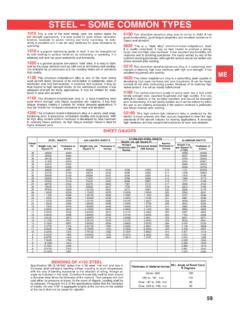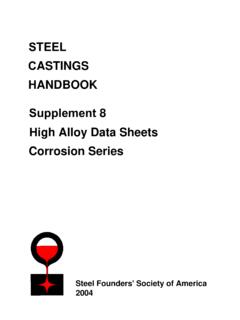Transcription of Chemical Composition of Structural Steels
1 Design of steel StructuresMIT Department of Civil and Environmental EngineeringSpring Semester, 1999 Chemical Composition of Structural SteelsThe primary types of Structural steel are usually classified according to the following chemicalcomposition categories: Carbon-manganese Steels High-strength, low-alloy (HSLA) Steels High-strength quenched and tempered alloy steelsThe carbon-manganese Steels , whose primary Chemical components are carbon andmanganese in addition to iron, are referred to ascarbon steelsormild Structural of this type are generally least expensive; they have quite adequate strength andductility characteristics, and are therefore by far the most widely used grades. One of the mostprominent of these Steels are ASTM grade A36, with a specified minimum yield stress high-strength low-alloy Steels represent a relatively recent development in higher strength (42 to 65ksi) is achieved by adding small amounts of additional chemicalelements.
2 Two of the most common HSLA Steels are ASTM grade A572 and high-strength quenched and tempered (Q&T) alloy Steels used for Structural purposes areessentially available only as grade A514 today. With a yield stress level of 90 to 100ksi,theincrease in strength is achieved through heat treatment. A514 is available only in plate form,up to 6 inches is a list of some important Chemical elements used in Structural Steels :Carbon (C)Next to iron, carbon is by far the most important Chemical element in the carbon content produces a material withhigher strengthandlower Steels , therefore, have carbon contents between to percent; if the carboncontent goes much higher, the ductility will be too low, and for magnitudes less than the strength will not be (Mn)Manganese appears in Structural steel grades in amounts ranging fromabout to percent.
3 It has effects similar to those of carbon, and the steel producer usesthese two elements in combination to obtain a material with the desired properties. Manganeseis a necessity for the process of hot rolling of steel by its combination with oxygen and (Al)Aluminum is one of the most importantdeoxidizersin the material, and alsohelps form a morefine-grained crystalline microstructure. It is usually used in combinationwith silicon to obtain a semi- or fully killed Design of steel StructuresMIT Department of Civil and Environmental EngineeringSpring Semester, 1999 Chromium (Cr)Chromium is present in certain Structural Steels in small amounts. It isprimarily used to increase thecorrosion resistanceof the material, and for that reason oftenoccurs in combination with nickel and copper. stainless steel will typically have significantamounts of chromium.
4 Thus, the well-known 18-8 stainless steel contains 18 percent ofnickel and 8 percent of (Cb)Columbium is astrength-enhancingelements, and is one of the importantcomponents in some of the HSLA Steels . Its effects are similar to those of manganese andvanadium; it also has somecorrosion resistanceinfluence. Cb appears in types 1 and 3 ofASTM (Cu)Copper is another primarycorrosion resistanceelements. It is typically foundin amounts not less than percent, and is the primary anti-corrosion component in steelgrades like A242 and (Mo)Molybdenum has effects similar to manganese and vanadium, and isoften used in combination with one or the other. It particularly increases thestrengthof thesteel athigher temperaturesand also improvescorrosion resistance. Typical amounts ofmolybdenum are to percent for certain grades of A588 steel , and percent for various types of (Ni)In addition to its favorable effect on thecorrosion resistanceof steel , nickelenhances the low-temperature behavior of the material by improving thefracture is used in Structural Steels in varying amount; for example, certain grades of ASTM A514have Ni contents between and percent; some types of A588 have nickel contentsfrom to (P) and Sulfur (S)Both of these elements are generallyundesirableinstructural steel .
5 Sulfur, in particular, promotes internal segregation in the steel matrix. Bothact to reduce the ductility of the material. All steel grade specifications, therefore, placesevere restrictions on the amount of P and S that are allowed, basically holding them to lessthan about to percent. Their detrimental effect on weldability is (Si)Along with aluminum, silicon is one of the principaldeoxidizersfor structuralsteel. It is the element that is most commonly used to produce semi- and fully killed Steels ,and normally appears in amounts less than (V)The effects of this Chemical element are similar to those of Mn, Mo, and helps the material develop afiner crystalline microstructureand gives increasedfracturetoughness. Vanadium contents of to percent are used in ASTM grades A572 andA588, and in amounts of to percent in Chemical elementsCertain steel grades utilize small amounts of other alloyingelements, such as boron, nitrogen, and titanium.
6 These elements normally work in conjunctionwith some of the major components to enhance certain aspects of the material 2


















